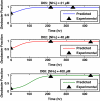Genome-scale dynamic modeling of the competition between Rhodoferax and Geobacter in anoxic subsurface environments
- PMID: 20668487
- PMCID: PMC3105697
- DOI: 10.1038/ismej.2010.117
Genome-scale dynamic modeling of the competition between Rhodoferax and Geobacter in anoxic subsurface environments
Abstract
The advent of rapid complete genome sequencing, and the potential to capture this information in genome-scale metabolic models, provide the possibility of comprehensively modeling microbial community interactions. For example, Rhodoferax and Geobacter species are acetate-oxidizing Fe(III)-reducers that compete in anoxic subsurface environments and this competition may have an influence on the in situ bioremediation of uranium-contaminated groundwater. Therefore, genome-scale models of Geobacter sulfurreducens and Rhodoferax ferrireducens were used to evaluate how Geobacter and Rhodoferax species might compete under diverse conditions found in a uranium-contaminated aquifer in Rifle, CO. The model predicted that at the low rates of acetate flux expected under natural conditions at the site, Rhodoferax will outcompete Geobacter as long as sufficient ammonium is available. The model also predicted that when high concentrations of acetate are added during in situ bioremediation, Geobacter species would predominate, consistent with field-scale observations. This can be attributed to the higher expected growth yields of Rhodoferax and the ability of Geobacter to fix nitrogen. The modeling predicted relative proportions of Geobacter and Rhodoferax in geochemically distinct zones of the Rifle site that were comparable to those that were previously documented with molecular techniques. The model also predicted that under nitrogen fixation, higher carbon and electron fluxes would be diverted toward respiration rather than biomass formation in Geobacter, providing a potential explanation for enhanced in situ U(VI) reduction in low-ammonium zones. These results show that genome-scale modeling can be a useful tool for predicting microbial interactions in subsurface environments and shows promise for designing bioremediation strategies.
Figures







Similar articles
-
Coupling a genome-scale metabolic model with a reactive transport model to describe in situ uranium bioremediation.Microb Biotechnol. 2009 Mar;2(2):274-86. doi: 10.1111/j.1751-7915.2009.00087.x. Microb Biotechnol. 2009. PMID: 21261921 Free PMC article.
-
Influence of heterogeneous ammonium availability on bacterial community structure and the expression of nitrogen fixation and ammonium transporter genes during in situ bioremediation of uranium-contaminated groundwater.Environ Sci Technol. 2009 Jun 15;43(12):4386-92. doi: 10.1021/es8031055. Environ Sci Technol. 2009. PMID: 19603651
-
Stimulating the in situ activity of Geobacter species to remove uranium from the groundwater of a uranium-contaminated aquifer.Appl Environ Microbiol. 2003 Oct;69(10):5884-91. doi: 10.1128/AEM.69.10.5884-5891.2003. Appl Environ Microbiol. 2003. PMID: 14532040 Free PMC article.
-
Dissimilatory Fe(III) and Mn(IV) reduction.Adv Microb Physiol. 2004;49:219-86. doi: 10.1016/S0065-2911(04)49005-5. Adv Microb Physiol. 2004. PMID: 15518832 Review.
-
Bioremediation of uranium-contaminated groundwater: a systems approach to subsurface biogeochemistry.Curr Opin Biotechnol. 2013 Jun;24(3):489-97. doi: 10.1016/j.copbio.2012.10.008. Epub 2012 Nov 16. Curr Opin Biotechnol. 2013. PMID: 23159488 Review.
Cited by
-
Fast-SNP: a fast matrix pre-processing algorithm for efficient loopless flux optimization of metabolic models.Bioinformatics. 2016 Dec 15;32(24):3807-3814. doi: 10.1093/bioinformatics/btw555. Epub 2016 Aug 24. Bioinformatics. 2016. PMID: 27559155 Free PMC article.
-
Metabolic cross-feeding interactions modulate the dynamic community structure in microbial fuel cell under variable organic loading wastewaters.PLoS Comput Biol. 2024 Oct 17;20(10):e1012533. doi: 10.1371/journal.pcbi.1012533. eCollection 2024 Oct. PLoS Comput Biol. 2024. PMID: 39418284 Free PMC article.
-
A road map for the development of community systems (CoSy) biology.Nat Rev Microbiol. 2012 Mar 27;10(5):366-72. doi: 10.1038/nrmicro2763. Nat Rev Microbiol. 2012. PMID: 22450377 Review.
-
Common principles and best practices for engineering microbiomes.Nat Rev Microbiol. 2019 Dec;17(12):725-741. doi: 10.1038/s41579-019-0255-9. Epub 2019 Sep 23. Nat Rev Microbiol. 2019. PMID: 31548653 Free PMC article. Review.
-
Salinity Impact on Composition and Activity of Nitrate-Reducing Fe(II)-Oxidizing Microorganisms in Saline Lakes.Appl Environ Microbiol. 2022 May 24;88(10):e0013222. doi: 10.1128/aem.00132-22. Epub 2022 May 2. Appl Environ Microbiol. 2022. PMID: 35499328 Free PMC article.
References
-
- Anesiadis N, Cluett WR, Mahadevan R. Dynamic metabolic engineering for increasing bioprocess productivity. Metab Eng. 2008;10:255–266. - PubMed
-
- Balba MT, Nedwell DB. Microbial metabolism of acetate, propionate and butyrate in anoxic sediment from the Colne Point Saltmarsh, Essex, UK. J Gen Microbiol. 1982;128:1415–1422.
-
- Burgard AP, Pharkya P, Maranas CD. Optknock: a bilevel programming framework for identifying gene knockout strategies for microbial strain optimization. Biotechnol Bioeng. 2003;84:647–657. - PubMed

